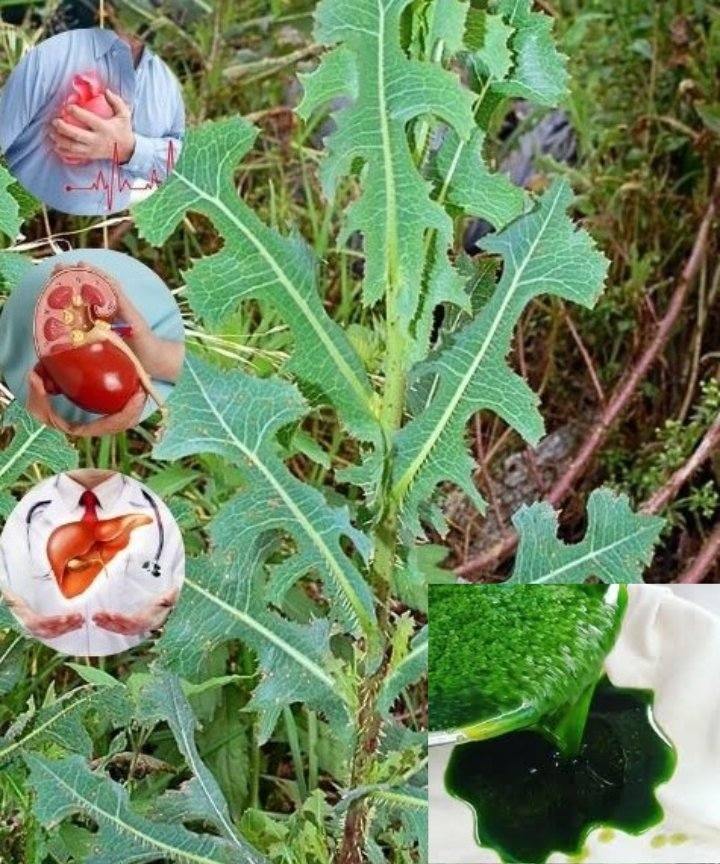Lactuca serriola, commonly known as prickly lettuce, is often dismissed as a common weed. However, this resilient plant holds a rich history of medicinal use and is a source of valuable nutrients. In this article, we’ll explore its properties, applications, and even how to prepare it for use.

1. Understanding Lactuca Serriola (Prickly Lettuce)
Origins and Appearance:
Prickly lettuce, native to Europe and Asia, has spread globally. It is identifiable by its tall stalks, bluish-green leaves with prickly edges, and small yellow flowers.
Historical Use:
Ancient Egyptians and Greeks valued it for its sedative properties and used it extensively in traditional medicine.
2. Medicinal and Nutritional Properties
Lactucarium – The “Lettuce Opium”
The plant’s milky sap, known as lactucarium, has mild sedative and pain-relieving effects.
Nutritional Value:
Prickly lettuce is rich in vitamins and minerals, including vitamin A, vitamin K, and iron.
Antioxidant Properties:
Studies indicate it may help reduce oxidative stress by neutralizing free radicals.
3. Harvesting Wild Lettuce
- For Culinary Use: Pick young, tender leaves, as mature leaves are bitter.
- For Medicinal Use: Harvest the sap by cutting the stem and collecting the milky liquid.
4. Using Prickly Lettuce – From Medicine to Meals
Medicinal Uses:
- Brew into teas or create tinctures to relieve anxiety and insomnia.
- Use fresh leaves in poultices for minor skin irritations.
Culinary Uses:
- Add young leaves to salads or stir-fries.
- Cook stems by boiling or sautéing.
Safety Tip: Proper identification is crucial to avoid toxic lookalikes. Always consult a healthcare professional before use.
5. Preparing Prickly Lettuce for Remedies
Fresh Plant Preparation:
- Remove leaves by sliding your hand against the growth direction.
- Blend fresh leaves with high-proof alcohol (190 proof) for a tincture. Let it steep for hours or weeks.
Drying the Plant:
- Use a dehydrator for consistent results.
- Once dry, grind the leaves into a fine powder.
Alcohol Extraction:
- Combine dried plant material with alcohol (4-5 times its weight).
- Steep for several days, occasionally shaking the jar.
- Heat gently (below 180°F) to enhance extraction.
Water Extraction:
- After alcohol extraction, add water (double the volume).
- Simmer gently (below 180°F) for a few hours, then strain the liquid.
6. Concentrating and Storing the Extract
- Reduce the Extract: Slowly evaporate the liquid by heating below 180°F until it becomes syrupy.
- Storage Options: Store the thick extract in a jar or dry it further on a silicone pad using a dehydrator (135°F) for a resin-like consistency.
7. Finishing the Remedy – Creating a Tincture
- Blend the concentrated extract with alcohol to create a liquid tincture.
- Store in labeled dropper bottles for easy use.
Dosage: Start with 2-3 dropperfuls diluted in water before bedtime, adjusting based on effectiveness.
Final Thoughts:
Prickly lettuce (Lactuca serriola) proves that valuable remedies often grow unnoticed. Its medicinal and culinary uses make it a worthwhile addition to any natural health toolkit. Approach its use with care and respect, and you may find it becomes a trusted part of your wellness routine.